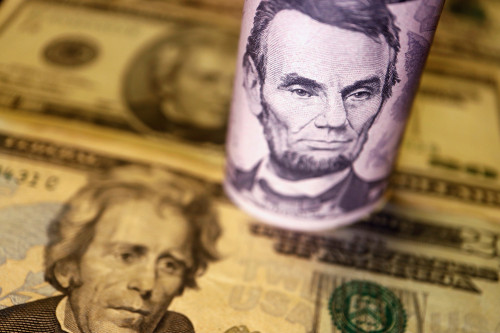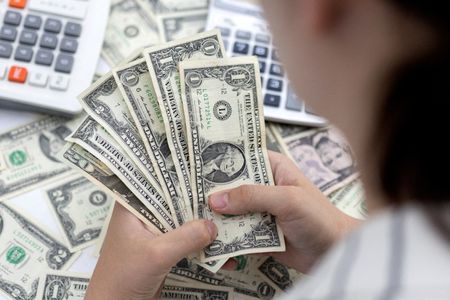By Sarupya Ganguly
BENGALURU (Reuters) – Falling demand for U.S. dollar-denominated assets will push the greenback lower in coming months, according to FX strategists surveyed by Reuters, as concerns mount about the U.S. federal deficit and debt.
U.S. President Donald Trump’s erratic tariff policies, along with the House of Representatives recently passing a tax-cut and spending bill that would add $3.3 trillion to an already-enormous $36.2 trillion debt pile, have many investors worried.
Long-term bond yields have soared on a rising ‘term premium’ – compensation for holding longer-duration debt – leading to swathes of asset outflows and a near-10% fall in the dollar against a basket of major currencies since mid-January.
Its usual close relationship with 10-year Treasury yields has also broken down.
Asked what would happen to demand for dollar-denominated assets in a May 30-June 4 poll, a near-90% majority, 59 of 66 FX strategists, said it would decline.
“It’s quite evident right now there is a ‘sell-America’ trade playing out, and how much dollar demand decreases depends on the extent to which U.S. growth is perceived to be hit by the current policies of the administration,” said Jane Foley, head of FX strategy at Rabobank.
“If the market is still anticipating the growth outlook will be undermined, the trend will be towards further dollar losses over the medium-term.”
Over 55% of analysts in a May Reuters poll also expressed concern about the dollar’s ‘safe haven’ status, up from only around one-third in April.
This month, over half of respondents upgraded their euro forecasts.
The common currency, currently $1.14, was predicted to hold steady in three months, gain about 1% to $1.15 in six and about a further 3% to $1.18 in a year.
Euro-dollar median forecasts recorded in the survey were the highest since November 2021. Only just in February, around one-third were expecting it to reach parity within a year.
But most of that has to do with the outlook for the dollar. A series of interest rate cuts this year from the European Central Bank while the Federal Reserve has stayed on hold would normally generate the opposite result on interest rate differentials.
“Over the summer, we’re expecting (U.S.) term premium risks on elevated fiscal concerns and hard labor market data starting to turn. That is a very negative combination for the dollar,” said Dan Tobon, head of G10 FX strategy at Citi.
“Our…target on euro-dollar has been $1.15, but we think it can get to $1.20. And that might happen sooner than we’re expecting if these catalysts do play out.”
Asked how a thinning dollar trade would evolve by end-June, half the strategists, 21 of 42, said there would not be much change from speculators’ current net-short position. Nineteen said there would be an increase in net-shorts, while two said decrease.
Asked which region would benefit the most from sustained dollar outflows, respondents mostly said Europe.
Despite a slight souring of sentiment owing to the Trump-led trade war, investors are still generally optimistic that infrastructure and defence spending plans, particularly in Germany, will revitalise the bloc’s long-sluggish economy.
“When you talk to clients in the European area, they feel like there’s a lot more potential positive catalysts for growth there – not just because of the money that will be spent on defence and infrastructure – but because there’s belief that’s actually the beginning of a lot of other structural changes,” Citi’s Tobon added.
Heightened uncertainty from rising U.S. inflation expectations – near their highest in at least four decades – has also effectively tied the Fed’s hands for the time being even though markets still expect two more cuts this year.
The ECB is expected to cut this week and possibly once more.
(Other stories from the June foreign exchange poll)
(Reporting by Sarupya Ganguly; Polling and analysis by Anant Chandak, Renusri K, Rahul Trivedi and Jaiganesh Mahesh; Editing by Ross Finley and Chizu Nomiyama)




